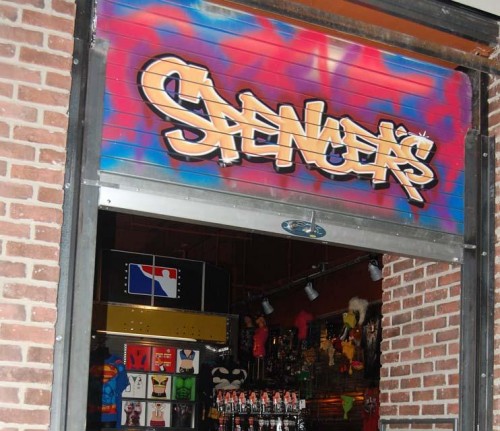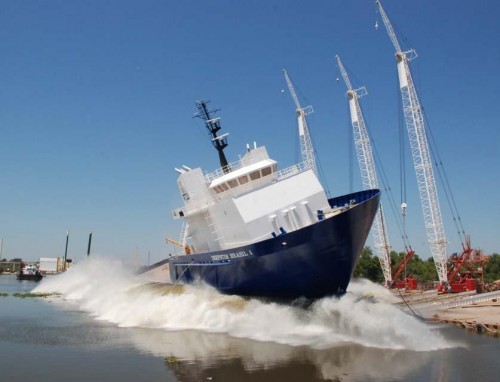
Officials not laughing at Spencer’s gifts
October 5, 2010
Bayou Cane uses grant money for fire safety
October 7, 2010Edison Chouest Offshore’s bi-monthly launch of its signature orange-colored supply vessels took a break last week to launch a 300-foot blue and white deepwater well stimulation vessel at North American Fabricators in Houma.
It is the 56th boat to be launched from North American Fabricators since its founding in 1986.
The boat, named Deepstim Brazil 1, is the first of the dozen deepwater diesel electric offshore supply vessels ECO announced plans to design last year. The vessel will head to Brazil after the inside has been finished, according to Edison Chouest spokesperson Lonnie Thibodeaux.
“Usually we do 280-foot supply vessels every two months, but this boat is a little different,” Thibodeaux said. “It’s not a typical supply boat.”
In addition to the added 20 feet in length, this new design increases the deadweight tonnage from 4,750 LT to 5,300 LT. Deck cargo capacity also increases from 10,000 to 11,000 square feet, according to Edison Chouest’s newsletter.
The vessel also features an optimized hull to create less drag in the water, and the diesel electric propulsion allows horsepower to be used on an as-needed basis, which in turn reduces the amount of fuel burned.
President and CEO of ECO, Gary Chouest, said the company launched another vessel the same morning, the Oiln Conqueror, a 244-foot anchor handling vessel, in Brazil – the first time the company has launched two vessels in the same day.
Chouest added Deepstim Brazil 1’s sister ship, also headed to Brazil, will be ready in early December.
“We’re not only dependent on the U.S. market,” Chouest said. “We’ve been looking at options all over and have been in that mode for many years. We look to see where we can get the best value for our equipment and we tend to gravitate to those markets. However, we tend to build all our vessels as possible in the Louisiana area because the work ethic of the ship builders here we find to be some of the best in the world.”
And in order to utilize these shipbuilders, Chouest said his company has been working diligently to move forward on its newest $100 million shipbuilding venture, LaShip, which broke ground in March 2008.
“We are still in the construction phase,” he said. “We’re doing the electrical and finishing the physical shipyard itself, and we hope to have that completed within about six weeks. It looks like the last thing to be completed is the dredging, which is important to get done in order to get the vessels to the dock.”
Chouest said he expects construction of vessels to begin at LaShip around the New Year, which will begin to create more jobs in shipbuilding industry. He noted ECO has “help wanted” signs up at the shipyards in Larose and Houma.
Despite hardships some supply vessel companies have had to endure in light of the Deepwater Horizon rig explosion, Chouest said it hasn’t affected his shipyard, and the new regulations will determine any industry hardships in the future.
“I haven’t seen any impact on the yard with the spill, but if the effects of moratorium lingers on then it will affect the work at the new ship yard,” he said. “The new regulations will be a little stricter, but hopefully something the industry can live, work with and be profitable with. Eventually we’ll look back and say the moratorium is behind us and things are not as bad as they used to be.”
Moving forward, Chouest also said he’s anxious to get the dry dock project for LaShip’s shipyard contracted.
“It’s going to be expensive dry dock,” Executive Director for the Port of Terrebonne David Rabalais said.
“We bid it out already but we didn’t have enough money to build it so we had to regroup and had to go back and find some more money.”
Currently, the $25 million 320-foot dry dock project has $9 million from the state Department of Transportation and Development’s port priority program.
“[DOTD] gives the port money to improve infrastructure and lease improvement to potential tenants to generate revenue that stays in the port,” Rabalais said.
The dry dock also has $5 million from LaShip’s escrow account, and the Port of Terrebonne is working on another $10 million in hurricane recovery money to bridge the financial gap, according to Rabalais.
The large price tag is a match for the large size of the dry dock, but both Thibodeaux and Chouest assert the importance of the size.
“The initial design was always intended to be a large dry dock for large vessels,” Chouest said. “Our shipyard facility is capable of building extremely large vessels so we have to have a launching system to match the building capabilities.”
Rabalais hopes to bid the dry dock project out within the next month.
“Hopefully we can get it done, because it’s important to what we do at the shipyard,” Chouest said.
The 300-foot Deepstim Brazil 1 was launched last week at North American Fabricators. It is the first of a dozen diesel electric offshore supply vessels planned for design, as announced by Edison Chouest last year. JENNA FARMER









